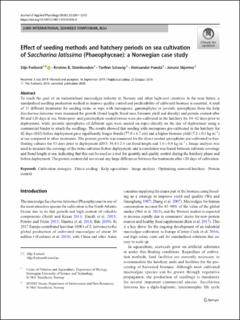| dc.contributor.author | Forbord, Silje | |
| dc.contributor.author | Steinhovden, Kristine | |
| dc.contributor.author | Solvang, Torfinn | |
| dc.contributor.author | Handå, Aleksander | |
| dc.contributor.author | Skjermo, Jorunn | |
| dc.date.accessioned | 2021-01-20T09:07:44Z | |
| dc.date.available | 2021-01-20T09:07:44Z | |
| dc.date.created | 2020-11-10T13:12:11Z | |
| dc.date.issued | 2020 | |
| dc.identifier.citation | Journal of Applied Phycology. 2020, 32 (4), 2201-2212. | en_US |
| dc.identifier.issn | 0921-8971 | |
| dc.identifier.uri | https://hdl.handle.net/11250/2723824 | |
| dc.description.abstract | To reach the goal of an industrialised macroalgae industry in Norway and other high-cost countries in the near future, a standardised seedling production method to improve quality control and predictability of cultivated biomass is essential. A total of 11 different treatments for seeding twine or rope with meiospores, gametophytes or juvenile sporophytes from the kelp Saccharina latissima were measured for growth (frond length, frond area, biomass yield and density) and protein content after 80 and 120 days at sea. Meiospore- and gametophyte-seeded twines were pre-cultivated in the hatchery for 14–42 days prior to deployment, while juvenile sporophytes of different ages were seeded on ropes directly on the day of deployment using a commercial binder to attach the seedlings. The results showed that seeding with meiospores pre-cultivated in the hatchery for 42 days (S42) before deployment gave significantly longer fronds (77.0 ± 6.7 cm) and a higher biomass yield (7.2 ± 0.1 kg m−1) at sea compared to other treatments. The poorest growth was measured for the direct-seeded sporophytes pre-cultivated in free-floating cultures for 35 days prior to deployment (D35; 34.4 ± 2.4 cm frond length and 1.6 ± 0.4 kg m−1). Image analysis was used to measure the coverage of the twine substrate before deployment, and a correlation was found between substrate coverage and frond length at sea, indicating that this can be used as a tool for quantity and quality control during the hatchery phase and before deployment. The protein content did not reveal any large differences between the treatments after 120 days of cultivation. | en_US |
| dc.language.iso | eng | en_US |
| dc.publisher | Springer | en_US |
| dc.rights | Navngivelse 4.0 Internasjonal | * |
| dc.rights.uri | http://creativecommons.org/licenses/by/4.0/deed.no | * |
| dc.title | Effect of seeding methods and hatchery periods on sea cultivation of Saccharina latissima (Phaeophyceae): a Norwegian case study | en_US |
| dc.type | Peer reviewed | en_US |
| dc.type | Journal article | en_US |
| dc.description.version | publishedVersion | en_US |
| dc.source.pagenumber | 2201-2212 | en_US |
| dc.source.volume | 32 | en_US |
| dc.source.journal | Journal of Applied Phycology | en_US |
| dc.source.issue | 4 | en_US |
| dc.identifier.doi | 10.1007/s10811-019-01936-0 | |
| dc.identifier.cristin | 1846546 | |
| dc.description.localcode | Open Access This article is licensed under a Creative Commons Attribution 4.0 International License, which permits use, sharing, adaptation, distribution and reproduction in any medium or format, as long as you give appropriate credit to the original author(s) and the source, provide a link to the Creative Commons licence, and indicate if changes were made. The images or other third party material in this article are included in the article's Creative Commons licence, unless indicated otherwise in a credit line to the material. If material is not included in the article's Creative Commons licence and your intended use is not permitted by statutory regulation or exceeds the permitted use, you will need to obtain permission directly from the copyright holder. To view a copy of this licence, visit http://creativecommons.org/licenses/by/4.0/. | en_US |
| cristin.ispublished | true | |
| cristin.fulltext | original | |
| cristin.qualitycode | 1 | |

